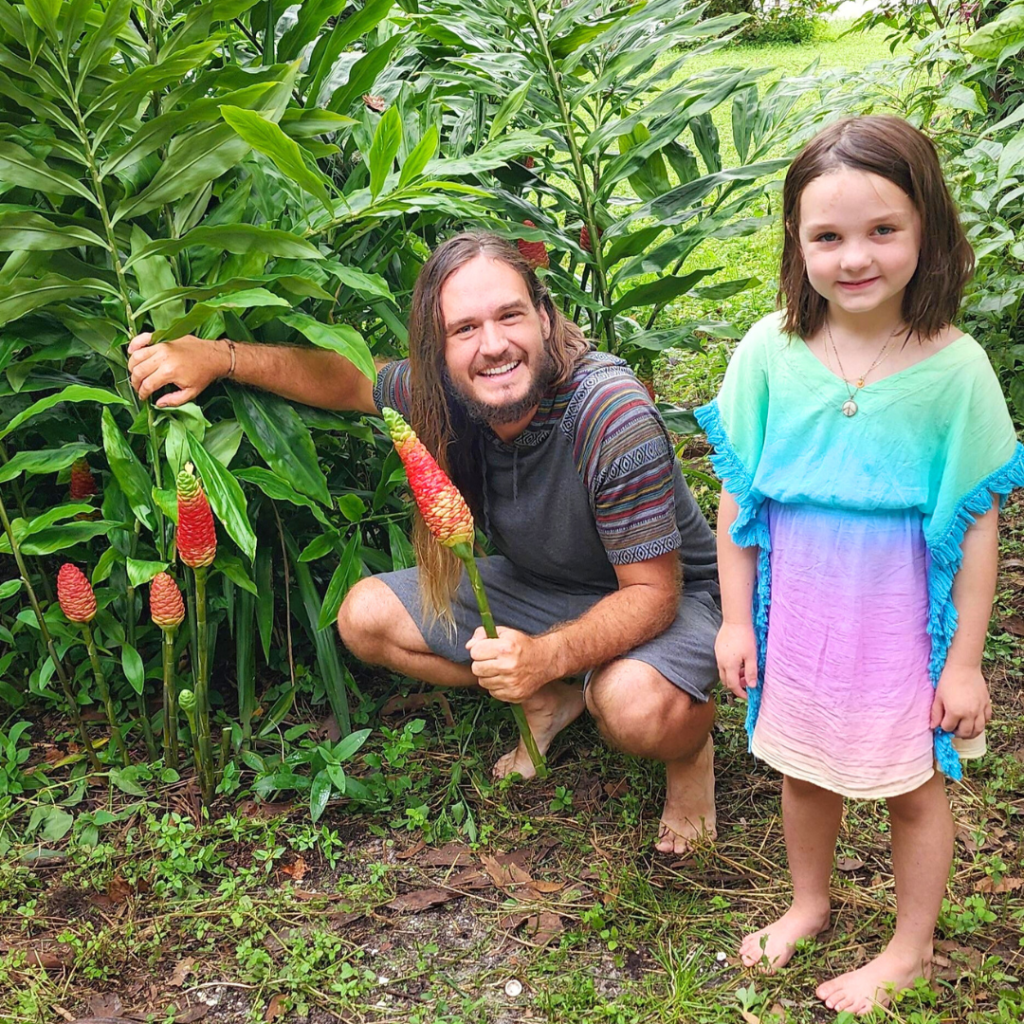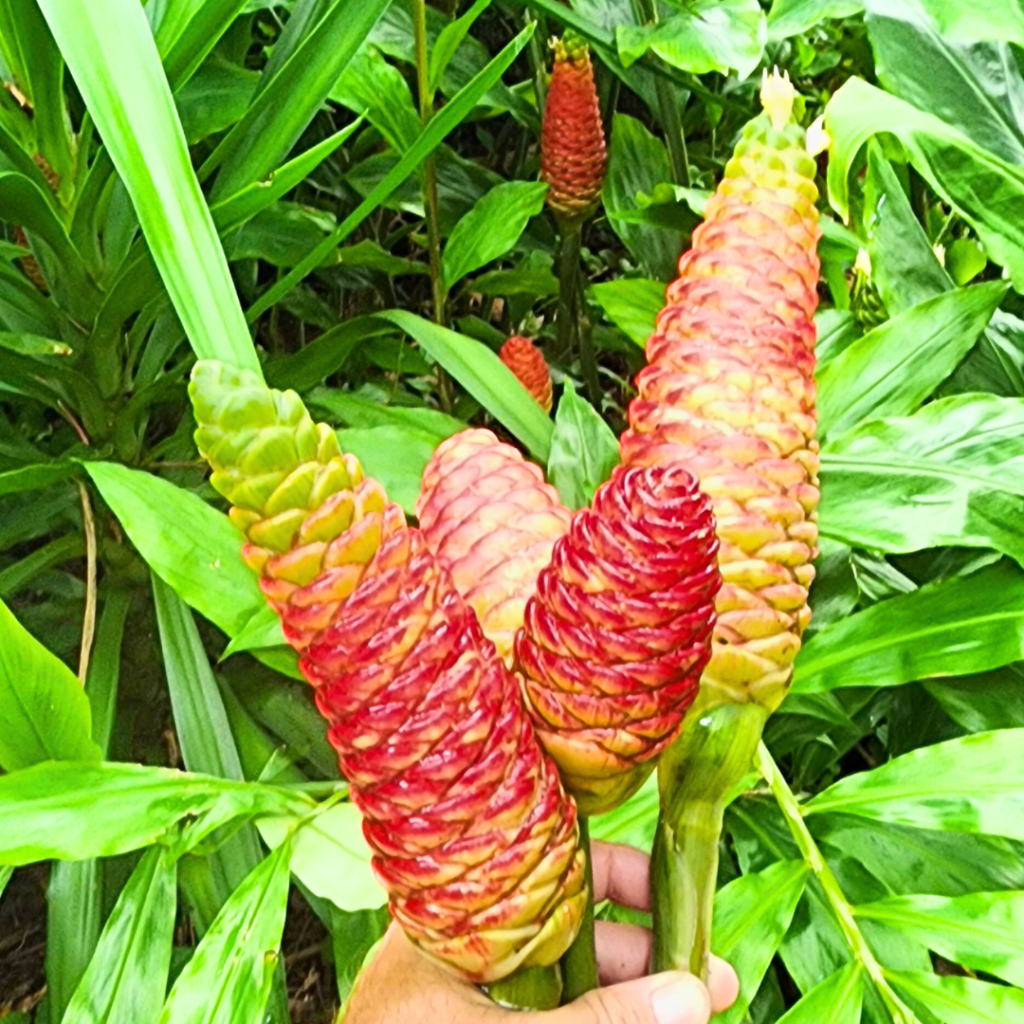Shampoo ginger, also known as pinecone ginger or awapuhi (Zingiber zerumbet), is a fascinating and practical addition to any tropical garden. Not only does it bring an exotic touch to your landscape, but it also offers a natural, eco-friendly hair care product straight from the garden! Right now, the flowers of this plant are peaking locally, and it is also one of the many plants sold yearly at our Annual Plant Sale!

Unique Beauty and Functionality
This striking plant thrives in USDA zones 9 through 11, so almost all of Florida can enjoy this beautiful Florida-Friendly and tropical looking plant. However most seasonal residents should avoid this plant as it goes dormant during the cooler months. The foliage, which sprouts in the spring, is lush and tropical and usually around 5′ tall. While its foliage may blend in with other gingers, shampoo ginger really shines in late summer and fall when its unique inflorescences emerge.
These cone-shaped bracts, resembling bright red pinecones, are a signature feature. Starting off green, they gradually ripen to a deep scarlet hue and emit a sweet ginger fragrance. Hidden within the colorful bracts are tiny white flowers, but what makes shampoo ginger particularly special is the clear, very fragrant liquid that can be harvested from the cones. By gently squeezing the ripe cones, you can collect a natural liquid that has long been used as a shampoo or body wash. It is said to be great for softening and adding a glossy look to hair naturally.
One of the few plants Polynesian’s brought across the Pacific Ocean to Hawaii a thousand years ago, it also deeply important and utilitarian in the Hawaiian culture. The leaves and roots (rhizomes) were utilized for culinary and medicinally purposes. Such as burning fresh leaves under meat to flavor it and turning the rhizomes into a powdered extract.
Planting and Care Tips
Shampoo ginger is adaptable to various planting locations and makes a fantastic choice for borders, specimen plants, or even container gardening. When choosing a site, aim for a spot that offers partial sun to partial shade and moist, fertile soil. The edge of a swale or low spot is ideal. Personally, I dream of the day I have an outdoor shower as the moisture and water would create a symbiotic spot for this plant. The plant requires minimal care, with very few pest or disease issues when planted in the right place. Because shampoo ginger spreads through rhizomes, it’s easily propagated by division, making it an excellent pass-along plant to share with friends and fellow gardeners. This is another reason it is commonly found for sale at Master Gardener Volunteer sales.

Harvesting Shampoo Ginger
When the cones turn bright red, they’re ready to be harvested for their liquid. To collect it, simply give the cone a gentle squeeze over a container, and the clear, pleasantly fragrant liquid will flow out. If handled carefully, the cones will continue to refill with liquid, making them an ongoing source of natural shampoo. However, if you’re looking to extract all the liquid at once, you can firmly squeeze the cones, though they won’t replenish after this method. For longer storage, the liquid can be frozen and used later.
A Tropical Marvel for Your Garden
Whether you’re looking to add a tropical flair to your landscape, create a natural shampoo, or attract hummingbirds to your yard, shampoo ginger is a versatile and beautiful choice. Its unique blend of practicality and ornamental value makes it a standout plant for any gardener who enjoys merging nature with everyday living. Will you be adding this Florida-Friendly plant into your garden?
Resources:
- UF/IFAS Gardening Solutions: Shampoo Ginger https://gardeningsolutions.ifas.ufl.edu/plants/ornamentals/shampoo-ginger/
- UF/IFAS Invasive Assessment Shampoo Ginger: https://assessment.ifas.ufl.edu/assessments/zingiber-zerumbet/
- UF/IFAS Historical Document on Shampoo Ginger: https://hort.ifas.ufl.edu/database/documents/pdf/shrub_fact_sheets/zinzera.pdf
- North Carolina Extension on Shampoo Ginger: https://plants.ces.ncsu.edu/plants/zingiber-zerumbet/
- Missouri Botanical Garden on Shampoo Ginger: https://www.missouribotanicalgarden.org/PlantFinder/PlantFinderDetails.aspx?taxonid=287581
During the preparation of this work, the author used ChatGPT to help build the blog post. After using this tool/service, the author reviewed and edited the content, and takes full responsibility for the content of the publication.
 14
14
